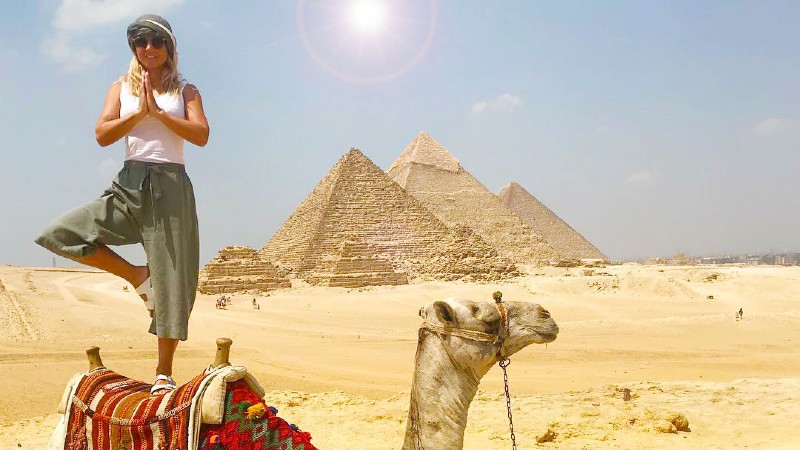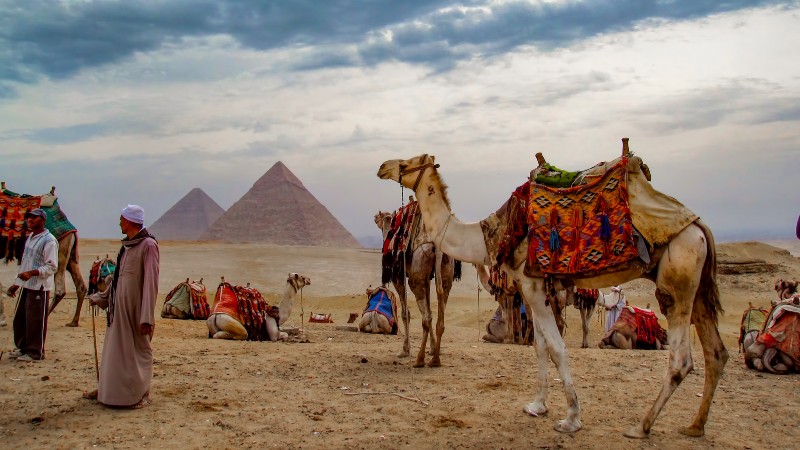Egyptian pyramids of Giza History :
The 10 pyramids of Giza, Egypt, one of the Seven Wonders of Antiquity, were built in Giza, not far from the then capital of Memphis (80km southwest of Cairo), above the desert on both sides of the Nile, and are the highest architectural achievement of the ancient Egyptian period. The pyramids were so tall that it was easy to phase in the ancient legend that they were built by gods or giants.

All you need to know in detail about Egypt Tour Packages & Tours
Who built the pyramids?
Egyptologists and historians have long argued about who and how the Pyramids created. A king could not have completed all three of the Giza Pyramids in his lifetime, and it is impossible to believe. Scholars believe they erected for three pharaohs: father, son, and grandson (Khufu, Khafre, and Menkaure).
Egyptologists Mark Lehner and Zahi Hawass have sought to locate the 20,000 or 30,000 workers who constructed the Pyramids. They seek to understand more about the workers, their everyday lives, and their origins. Meanwhile, Lehner has been excavating the bakeries that fed this army of laborers while Hawass dug their graves
How tall are The pyramids ?
The three largest and best-preserved pyramids were built by the three emperors of the Fourth Dynasty, Khufu, Khafra, and Menkaura, between 2600 and 2500 B.C.
- The pyramid of Khufu is 146.6m high and 230.35m long at the base.
- the pyramid of Khafra is 143.5m high and 215.25m long at the base.
- the pyramid of Menkaura is 66.4m high and 108.04m long at the base.
The largest of these 3 great pyramids is the Pyramid of Khufu, which is an almost solid megalithic body built with more than 2 million megaliths.
Hordes of men hauled these boulders up the slope of the ground and then stacked them in layers around the pyramid in a kind of scaffolding.
Next to the pyramids are small pyramids and rectangular tabletop tombs of royalty and nobility.
what did the pyramids look like?
The beautiful pyramids of Giza Almost all of the grayish-white limestone blocks that originally covered the pyramids with a polished outer layer have disappeared.
What is seen today is the yellowish lime boulders underneath, revealing their inner structure.
Inside the pyramids:
In the center of the pyramid, there is the burial chamber, which can be entered through a canal, with several tens of tons of boulders erected in layers on top of the chamber.
The completed pyramid was used as a mausoleum. The ancient Egyptians believed in eternal life after death, and the tombs of the pyramids were initially piled with gold and various valuables.
The Pyramid of Khufu is the largest of the 10 pyramids, and next to the foyer of the sacrificial hall of the Pyramid of Khafra, there is a sphinx about 20m high and 46m long, mostly chiseled out of the rock in situ.

All you need to know in detail about Egypt Tour Packages & Tours
What was the main purpose of the Pyramids of Giza?
At that time, the Nile River flooded every year and inundated the fields for 3-4 months. Farmers and laborers were unable to farm the land, so they found work building tombs.
The work to build a pyramid tower of Giza in the protection of the pyramids could take up to 30 years.
Due to the Egyptian concept of life and death and the influence of the belief in the sun god, it is believed that the sun rises in the east and sets in the west every day, just like being born in the east and dying in the west every day, so the pyramids were built on the west side of the Nile.
The construction of the pyramids reflects the consciousness people gained from the cycle of seasons and the cycle of life and death of crops in the purely agrarian era.
The ancient Egyptians believed that after death, the soul is immortal, and as long as the body is protected, it will be resurrected to eternal life in the Elysium after 3,000 years, so they paid special attention to the construction of tombs.
Reason for the arrangement:
The arrangement of the three Egyptian pyramids of Giza is according to The Belt of Orion, and the Nile is the arrangement of the pyramids of Giza as the Milky Way.
Because the Earth has the problem of the number of years (precession), it is according to the celestial sign of 1050BC. Orion was important to the Egyptians because they believed that the gods lived in Orion, which is where the heavens are located.
The pyramids are all orthogonal, but they meet each other in diagonal lines, creating a jagged outline of the complex.
The contrast between the realistic nature of the sphinx and the abstract nature of the pyramids in the foyer of the ceremonial hall of the Pyramid of Khafre makes the whole complex more varied and complete.
Measurements and Constellations:
The four sides of the base of King Khufu’s pyramid are almost due north, south, east, and west, with an error of less than one degree. Although stargazing is used to determine the orientation, the naked eye can make the error less than 1 degree.
Are all the pyramids aligned?
The Egyptian pyramids are among the most spectacular ancient structures, and many are precisely orientated. The first surveyed the Giza pyramids precisely in the 19th century, and they discovered that each of the pyramids’ four edges points in a cardinal direction to within a quarter degree.
But how did Egypt know? Glen Dash, a Giza pyramid expert, has suggested a hypothesis. He uses the “Indian circle” approach, which uses a shadow casting stick and thread to create an east-west orientation. He explained how they might have utilized this technology to build the pyramids.

What star system are the pyramids aligned with?
Back in 2500 B.C., four pits were found to point to four particular stars that were crossing the meridian at that time.
They are the second star of the constellation Ursa Minor, the brightest star of Canis Major, Sirius, the North Star, and the first star of the constellation Lepus “The right pole star. Using computers, we proved that around 2500 B.C.,
What is the relationship between the Great Pyramid and the stars?
the four craters of the Great Pyramid were aligned with the four stars. And it is also known that the correspondence between the craters and the stars, due to the transverse latitude constantly changing and relatively ending, is only about a century.
This phenomenon is known as “age difference” in astronomy.
Are the Egyptian pyramids of Giza aligned with Orion’s belt?
The arrangement of the three pyramids of Giza and the arrangement of the three girdle stars in Orion have a special relationship. Using computer simulations back to 1050 B.C.,
the arrangement of the three stars of Orion across the meridian in the sky is the same as the arrangement of the three pyramids of Giza on earth, and the positions of the stars in the sky and the Nile on earth are symmetrical.
This correspondence between heaven and earth is not an accidental coincidence.
The legend of Giza pyramid building layout:
The legend of the architectural layout of the pyramids of Giza is due to the Egyptian concept of life and death and the influence of the belief in the sun god, that the sun rises from the east and sets from the west every day, just like being born in the east and dying in the west every day, so the pyramids are built on the west side of the Nile.
The three pyramids of Giza are arranged according to the Belt of Orion, with the Nile as the Milky Way. This is according to the celestial sign of 1050BC because the earth has the problem of precession. Orion was important to the Egyptians because they believed that the gods lived in Orion, where the heavens were located.
Pictures of Egyptian pyramids:
All you need to know in detail about Egypt Tour Packages & Tours
Facts about the Great Pyramids of Giza?
- More than 130 more pyramids have spread over Ancient Egypt, including Cheops (The Great Pyramid), Chephren, and Mycerinus.
- The Giza Pyramids are the oldest and only preserved marvel of the Ancient World. Included on this list were the lost Lighthouse of Alexandria, Colossus of Rhodes, and Statue of Zeus at Olympia, with the dispersed ruins of the Temple of Artemis in Turkey.
- The Great Pyramid is supposed to made up of approximately two million stone pieces weighing between two and fifty tonnes, yet how they carried is unknown. Historians believe that around 100,000 individuals worked building the Giza Pyramids and not enslaved people as previously supposed.
- The west bank of the Nile is where the sunsets every evening, symbolizing the abode of the dead. It is part of ancient Egyptian mythology.
- The Giza Pyramids previously encased in a white casing of polished limestone that reflected the sun’s beams. Unfortunately, the cases have either crumbled to rubble or been cut away and used to create new buildings.
- Despite the searing heat in Egypt, the temperature within the pyramids stays constant at 20 C, the global average.
- Although Egypt and the pyramids linked with hieroglyphics, the Great Pyramid of Giza has no writing or hieroglyphics of any type.
- Inside the Great Pyramid’s main chamber is a granite coffer that seems normal until you realize it is composed of one complete block of granite that is much too huge to fit via the narrow corridor you just squeezed through. History and archaeology now agree that the Great Pyramid was erected around the coffer rather than within it.
- The cornerstones of the pyramids are a fantastic illustration of how the Egyptians were ahead of their time. These were created in a ball and socket design to withstand earthquakes and thermal expansion.
- The Great Pyramid reportedly featured a swivel door that could be pulled open from the inside but not seen from the outside.













